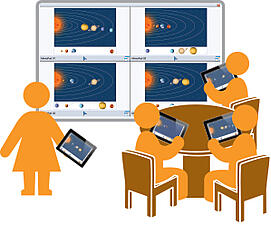 Creating a collaborative environment in classrooms is a key method of empowering students to live and thrive in the real world. Discussion, cooperation, open-mindedness, a variety of viewpoints, higher-order thinking skills, different curricular areas, disagreement, and debate are all elements that help students learn how to collaborate with others and thus become better educated individuals.
Creating a collaborative environment in classrooms is a key method of empowering students to live and thrive in the real world. Discussion, cooperation, open-mindedness, a variety of viewpoints, higher-order thinking skills, different curricular areas, disagreement, and debate are all elements that help students learn how to collaborate with others and thus become better educated individuals.
But how do educators incorporate collaborative learning models into their instruction? Start by setting expectations for your students, clearly explaining the process, and following these five collaboration strategies.
- Establish common goals. Have the group decide what the goal for the session should be. In the beginning, it may be a good idea to set an agenda for your students, or have them create one. An example of an agenda would be as follows:
- Compromise and listen. Set the ground rules. Collaboration isn't the fastest or easiest way to learn, but it will build other skills besides what the students are learning. They must be open to others' ideas, listen to all viewpoints, and be willing to compromise in order to reach a joint consensus.
- Assign roles and responsibilities. Have the students take on specific tasks within the group. In the beginning, this will help them determine how or what their function is within the group dynamic.
- Determine measures for accountability. Let the students know exactly how you will be measuring their success, so they will know what they are working towards. This will help them avoid drifting off the goal. It may be helpful to write these measures out clearly on the board, so they can always refer back to them.
- Assess progress and give feedback. Walk around and assess progress. Step in and give feedback when students need help, but also let them work some issues out on their own. True collaboration involves the group coming to a joint consensus on their own; an outside party should not be arbitrating every detail.
These five strategies are a great way to get your students started in collaborative learning! If you want to learn even more about collaboration in the classroom and see some lessons samples, download our Collaborate to
the Core guide.



